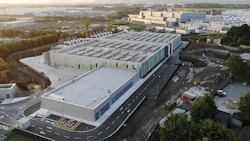The Data Center Frontier Executive Roundtable features insights from industry executives with lengthy experience in the data center industry. Here’s a look at the insights from Phillip Marangella of EdgeConneX.
Currently serving as the Chief Marketing Officer at EdgeConneX, Phillip Marangella has over 20 years of international marketing, strategy, and business development experience working in the Data Center, Telecom and Technology sectors for leading service providers.Prior to joining EdgeConneX, Phillip most recently worked for Equinix in various capacities in both marketing and business development. In addition, Phillip had stints at Coresite, Verizon, MCI, Nortel and Globalstar. Phillip was also a partner and founder of a tech consulting firm focused on international technology transfer and venture funding of university developed technology. Currently serving as the Chief Marketing Officer at EdgeConneX, Phillip is focused on developing, evangelizing and executing the marketing strategy and ecosystem development for the company. Phillip also serves on the advisory boards for Apomaya and Infrastructure Masons. Phillip holds a Bachelors in Political Science from the University of California San Diego, and a Masters in Multinational Commerce from Boston University.
Here’s the full text of Phillip Marangella’s insights from our Executive Roundtable:
Data Center Frontier: What will delivery timetables for new data center capacity look like in 2023? Will the combo of supply chain issues, power constraints and staff shortages have an impact on supply?
Phillip Marangella: The best thing about challenges like those faced today by the data center industry is, we learn to work smarter, faster, and better so we can bypass, adapt to, or just go right through the obstacles we are confronting. We learn to be better neighbors and collaborators with local communities. We make smarter decisions on power and land. We find ways to bring connectivity to the locations that need it most. We plan ahead to minimize the impacts of supply chain delays.
Today’s challenges may bring with them some near-term extensions in the capacity timeline, but in the long run they’ll make us a better, more nimble, more efficient industry.
Data Center Frontier: What’s the state of the edge computing market, and how does it compare to your expectations? What are the use cases that are gaining traction?
Phillip Marangella: The biggest change in the edge computing market is the expanding definition of "edge." At EdgeConneX, we’ve always said the edge is ubiquitous – it’s wherever your business needs to be. And today it’s more accurate than ever.
Different customers are defining their edge in ways that are uniquely useful to their business. For some customers, the edge might be a 1MW facility in a tier-3 market. For a major cloud provider, the edge might be a 40MW data center in a new market driven by data protection rules in that location. For still another business, the edge might be defined as a network of small-footprint locations spread across a continent, combining to deliver far-edge capacity for a narrow set of applications where proximity and low latency are key.
As a result, the opportunities at the edge are extremely promising, as long as you don’t allow yourself to be pigeon-holed into some out-of-date definition of the market in locations around the globe.
Data Center Frontier: How would you assess enterprise IT demand, and what do you see ahead in 2023?
Phillip Marangella: For years now we have watched enterprise customers pursue digital transformation projects and cloud looking to grow their capabilities and save money. And these are important, valuable steps for businesses to take. But it’s important to remember that they are a means, not an end.
So, today, as the cloud provider bills start to come due and as different providers offer different solutions, a lot of businesses are looking more closely at multi-cloud and hybrid cloud solutions. They understand that digital transformation is an ongoing process, not something they do once and forget about. As a result, demand may fracture a bit, as enterprises explore different paths to efficiency and optimization, but it will continue to grow around the globe.
Data Center Frontier: What will be the important themes in sustainability in 2023 for data centers and cloud operators?
Phillip Marangella: Given the number of corporate commitments to achieving specific sustainability goals by 2030 or 2040, data center providers and cloud operators need to view 2023 as a year for action, for transparency, and for measurability. Many of the sustainability goals defined by large service providers are aggressive and commendable. But as the end of the decade starts to loom larger and move toward us a lot more quickly, some of the tactics currently employed will come under greater, more public scrutiny by third parties. Actions will carry more weight than words in 2023.
In addition, it’s important to note that there is an important interplay between data center providers and customers when it comes to sustainability. The best, most efficient, most planet-friendly data center in the world won’t operate as effectively if they aren’t connected to the cleanest available energy sources or if waste, water, and emissions are not minimized at every step of the operations process.
A lot of these decisions are ultimately made by the customers of a data center and over time it will be incumbent on customers to factor in the cost-benefit analysis that drives some economic decision-making.







